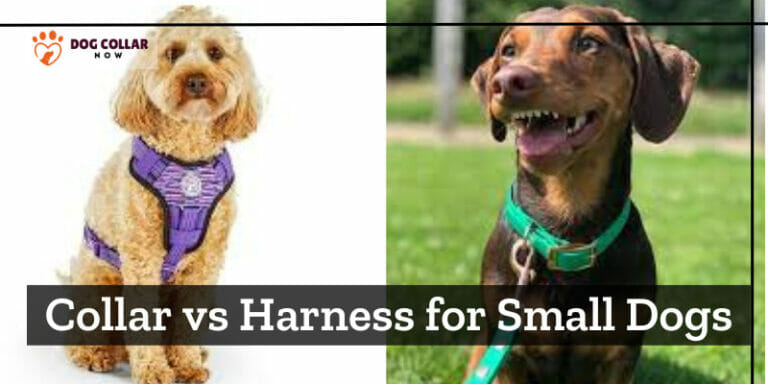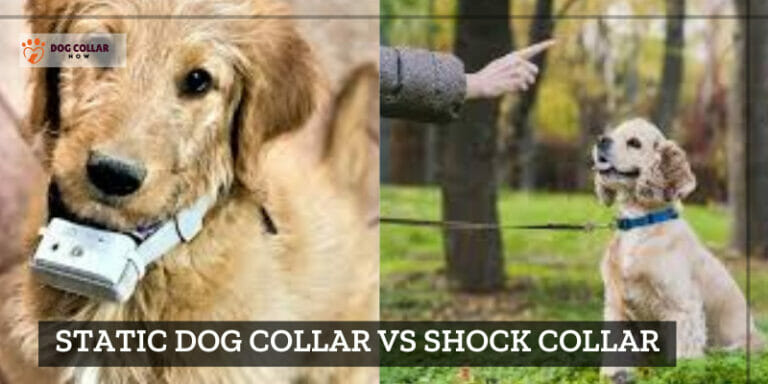GPS Dog Collar vs Invisible Fence – Comparison

When it comes to keeping our furry companions safe, as a pet owner, I often face a tough decision between GPS dog chokers and invisible fences.
In the world of pet safety, GPS dog collars provide real-time tracking for pet safety, while invisible fences create secure boundaries without obstructing vision.
The main difference between a GPS dog collar and vs Invisible fence is GPS dog collar allows you to track your dog’s location using satellite technology, while an invisible fence uses an underground boundary to keep your dog within a designated area.
Let’s explore the benefits and cons of each option to help you make an informed choice for your beloved pets.
GPS Dog Collar Vs Invisible Fence – What’s The Difference Between
- GPS dog collars use satellite tracking to monitor your pet’s location in real time, while virtual dog fences create an electric barrier.
- GPS chokers allow you to track your pet’s movements anywhere, without physical boundaries.
- Invisible GPS pet fences are generally more affordable and don’t require ongoing costs beyond the installation fee.
- GPS chokers may incur additional expenses for data plans or monitoring services.
- GPS collars provide peace of mind in knowing your pet’s location, while invisible GPS fence systems ensure they stay within a designated area.
- The choice between GPS chokers and virtual fences depends on factors like property size, budget, and desired freedom for your pet.
#1: GPS Dog Collar
Pros Of GPS Dog Collar
Wireless GPS systems have been gaining popularity among pet owners as an effective way to keep their furry friends safe. Here are some of the pros of using a GPS dog choker:
- Real-time tracking for enhanced pet safety.
- Convenient monitoring through smart devices.
- Customizable boundaries without physical barriers.
- Quick recovery in case of a pet’s disappearance.
- Peace of mind with location assurance.
There are many different advantages associated with using a wireless pet GPS to train your dog – from enhanced safety features to better monitoring.
Cons Of GPS Dog Collar
While GPS dog collars have a lot of benefits, there are also some downsides to consider before making a purchase. Here are some cons of using a GPS dog choker:
- Battery life: Remember to charge it regularly!
- Spotty GPS signals: Signal reliability may vary.
- Comfort and adjustment for your dog.
- Consider the cost: GPS chokers are pricier.
- Monitoring behavior: Introduce the collar carefully.
While GPS collars offer many advantages for keeping track of your furry friend’s whereabouts, it’s important to weigh both pros and cons before deciding whether this type of system is right for you and your pet.
Types Of GPS Dog Collar
Types of GPS dog chokers vary in design, features, and purposes. Some types are intended for use as training collars, while others are meant to track your dog’s location or monitor activity levels.
1: Standard tracking collar:
One type of GPS choker is the standard tracking collar that uses a receiver to pick up signals from a transmitter attached to your pet’s collar. These collars can be used both indoors and outdoors and provide real-time location data on your pet.
2: Hybrid radio:
Another type is the hybrid radio/GPS choker which combines two different technologies – FM radio frequencies and satellite positioning systems – for more precise tracking capabilities.
There are also multi-purpose GPS collars available that not only track your dog but also monitor its health through various sensors such as temperature sensors.
Some manufacturers offer specialized GPS hunting pet collars with additional features like point-of-view cameras for capturing footage of the hunt or remote-operated training modes.
How To Choose The Best GPS Collar For Your Pet?
According to my personal experience, GPS chokers utilize satellite technology to track your dog’s real-time location, offering peace of mind and quick retrieval in case of wandering or emergencies. With smartphone connectivity and notifications, they provide enhanced security and safety.
2) Invisible Fence
Pros Of Invisible GPS Dog Fence
Invisible fences have become a popular option for pet owners who want to keep their dogs safe and secure without the hassle of traditional physical fences. Here are some of the pros:
- Invisible pet fences are less expensive than traditional physical fences, making them an affordable option for many people.
- They allow your dog to roam freely within the boundaries you set, giving them more freedom while still keeping them safe.
- Virtual fences are easy to install and can be customized to fit any yard or property size.
- Unlike electric dog fences, which use shock collars as a deterrent, virtual fences use only warning signals such as beeps or vibrations. This means that your dog won’t experience pain or injury if they cross the boundary line.
- With proper training, virtual fence systems can effectively teach your dog where it is safe to go and where it should not venture.
- Virtual fence systems don’t obstruct views like traditional physical fences do, so you can maintain an unobstructed view of your surroundings while still keeping your pet safely contained on your property.
Cons Of Invisible GPS Dog Fence
While a virtual fence may seem like a great option for keeping your dog safely contained in your yard, there are some potential drawbacks to consider before investing in this type of system.
- May not be effective for all dogs
- The collar can cause discomfort and pain to your dog
- Does not prevent other animals from entering your yard
- Does not protect your dog from external threats
Types Of Invisible Fences
- Wired virtual fence: Requires burying a wire around the yard.
- Wireless virtual fence: Relies on a signal from a central base station.
- Underground virtual fence: Utilizes buried wires to create a boundary.
- Radio Frequency virtual fence: Emits a signal through radio waves.
- GPS-Based virtual fence: Uses GPS technology for boundary tracking.
- Hybrid virtual fence: Combines wired and wireless elements.
- In-ground virtual fence: Buried wire creates an invisible boundary.
- Virtual fence: Digital technology defines the containment area.
- Electric Dog Fence: Delivers a mild electric shock to deter crossing.
- Wireless Containment System: Provides wireless boundary control.
How To Choose The Best Dog Invisible Fence For Your Dog?
According to my personal experience, Invisible/ virtual fences establish a safe boundary for dogs to freely roam without physical barriers. By delivering a mild shock if they cross the boundary, these fences prevent straying while maintaining the yard’s aesthetics and allowing dogs to explore with freedom.
Factors To Consider While Buying GPS Dog Collar Vs Invisible Fence
When it comes to keeping your furry friend safe, there are a lot of options out there. Two popular choices are GPS chokers and virtual fences. If you’re deciding between the two, here are some factors to consider:
Personality And Behavior
Firstly, think about your dog’s personality and behavior. Do they tend to roam off on their own or stay close by? A GPS choker may be better for a wandering pup while a virtual fence might work well for a dog that stays put.
Area
Consider also how large your property is and what kind of terrain it has. A virtual fence requires installation around the perimeter of your yard, which can be time-consuming if you have a large area with lots of obstacles, like trees or hills.
On the other hand, a GPS choker works wherever there is a GPS signal so it might be more practical if you have acres to spare.
Budget
Take into account your budget. Wireless invisible fences for dogs can be expensive due to installation fees whereas GPS chokers require only an initial purchase cost plus subscription fees if applicable.
Both options have their pros and cons but choosing one ultimately depends on what works best for you and your pet’s unique needs!
Conclusion
After comparing the pros, cons, and types of both GPS collars vs invisible fences, it’s clear that each option has its own benefits depending on your specific needs.
For active pet owners seeking safety on outdoor adventures, GPS chokers offer real-time tracking and virtual boundaries.
Meanwhile, an invisible fence system is ideal for containing dogs around the home without physical barriers.
Ultimately, the decision between these two options will depend on what matters most to you as a pet owner – whether that’s tracking real-time movements or setting firm boundaries at home.
FAQs
What is the difference between a wired and wireless invisible dog fence?
A wired electronic dog fence requires the installation of a physical wire around the boundary, while a wireless electric fence creates a boundary using wireless signals sent from a transmitter.
How effective are wireless dog fence systems?
Virtual dog fences can be effective in keeping dogs within a designated area, but their effectiveness depends on the individual dog and their personality and training.
Can a GPS dog choker be used in place of an invisible dog fence?
No, a GPS dog choker does not create a physical barrier to keep your dog within a designated area. It is simply a way to track your dog’s location.
How do in-ground dog fences work?
In-ground dog fences work by burying a wire around the perimeter of your yard. The wire creates an invisible boundary that, when approached by your dog’s collar, triggers an alert to the receiver collar and warns the dog to stop.
What happens if my dog gets too close to the boundary of the fence?
If your dog gets too close to the boundary of the fence, the collar will emit a warning sound or vibration. If your dog continues to approach, a static correction will be delivered through the collar.
How do I keep my dog safe with a wired pet fence?
To keep your dog safe with a wired pet fence, be sure to properly train your dog to understand the boundaries and always supervise your dog when he or she is outside.
References:
https://www.ipetguides.com/gps-dog-collar-vs-invisible-fence/
https://www.dogwatch.com/dogwatch-blog/do-gps-dog-fences-actually-work-heres-everything-you-need-to-know/
https://www.akc.org/expert-advice/home-living/what-is-a-gps-dog-fence-and-how-do-they-work/








